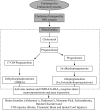Altered lipid metabolism in brain injury and disorders
- PMID: 18751914
- PMCID: PMC2293298
- DOI: 10.1007/978-1-4020-8831-5_9
Altered lipid metabolism in brain injury and disorders
Abstract
Deregulated lipid metabolism may be of particular importance for CNS injuries and disorders, as this organ has the highest lipid concentration next to adipose tissue. Atherosclerosis (a risk factor for ischemic stroke) results from accumulation of LDL-derived lipids in the arterial wall. Pro-inflammatory cytokines (TNF-alpha and IL-1), secretory phospholipase A2 IIA and lipoprotein-PLA2 are implicated in vascular inflammation. These inflammatory responses promote atherosclerotic plaques, formation and release of the blood clot that can induce ischemic stroke. TNF-alpha and IL-1 alter lipid metabolism and stimulate production of eicosanoids, ceramide, and reactive oxygen species that potentiate CNS injuries and certain neurological disorders. Cholesterol is an important regulator of lipid organization and the precursor for neurosteroid biosynthesis. Low levels of neurosteroids were related to poor outcome in many brain pathologies. Apolipoprotein E is the principal cholesterol carrier protein in the brain, and the gene encoding the variant Apolipoprotein E4 is a significant risk factor for Alzheimer's disease. Parkinson's disease is to some degree caused by lipid peroxidation due to phospholipases activation. Niemann-Pick diseases A and B are due to acidic sphingomyelinase deficiency, resulting in sphingomyelin accumulation, while Niemann-Pick disease C is due to mutations in either the NPC1 or NPC2 genes, resulting in defective cholesterol transport and cholesterol accumulation. Multiple sclerosis is an autoimmune inflammatory demyelinating condition of the CNS. Inhibiting phospholipase A2 attenuated the onset and progression of experimental autoimmune encephalomyelitis. The endocannabinoid system is hypoactive in Huntington's disease. Ethyl-eicosapetaenoate showed promise in clinical trials. Amyotrophic lateral sclerosis causes loss of motorneurons. Cyclooxygenase-2 inhibition reduced spinal neurodegeneration in amyotrophic lateral sclerosis transgenic mice. Eicosapentaenoic acid supplementation provided improvement in schizophrenia patients, while the combination of (eicosapentaenoic acid + docosahexaenoic acid) provided benefit in bipolar disorders. The ketogenic diet where >90% of calories are derived from fat is an effective treatment for epilepsy. Understanding cytokine-induced changes in lipid metabolism will promote novel concepts and steer towards bench-to-bedside transition for therapies.
Keywords: Atherosclerosis; Cholesterol; Inflammation; Neurodegenerative diseases; Stroke.
Figures



References
-
- Adibhatla RM, Hatcher JF. Phospholipase A2, reactive oxygen species, and lipid peroxidation in cerebral ischemia. Free Radic Biol Med. 2006;40:376–87. - PubMed
Publication types
MeSH terms
Substances
Grants and funding
LinkOut - more resources
Full Text Sources
Other Literature Sources
Medical
Research Materials
